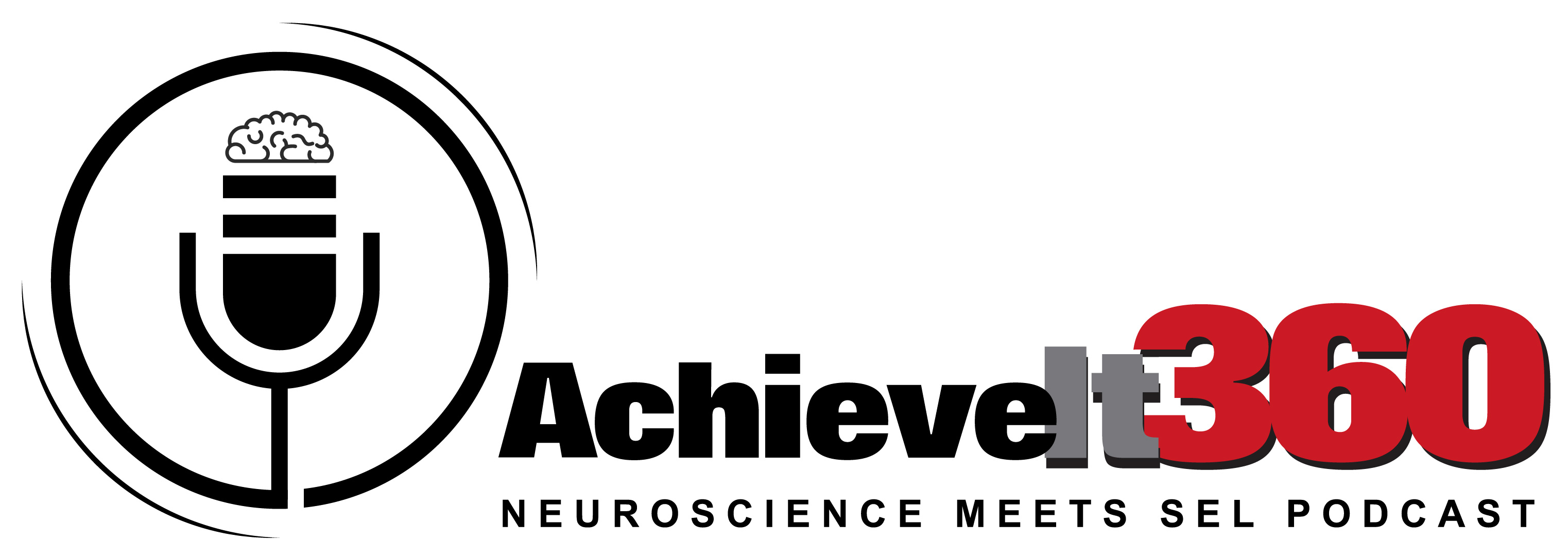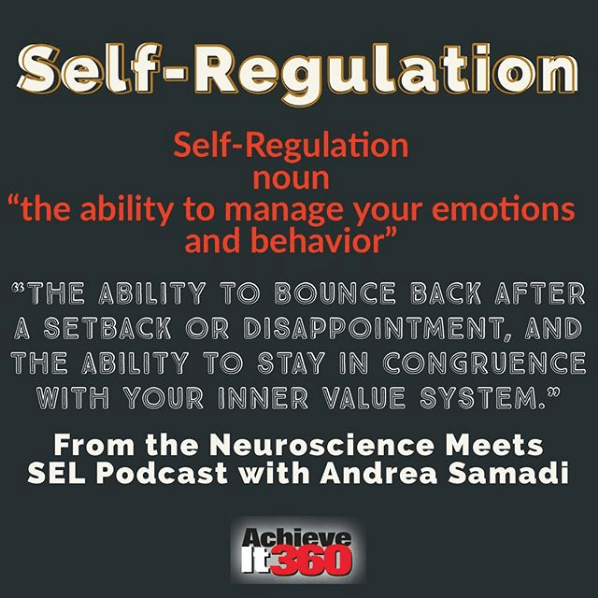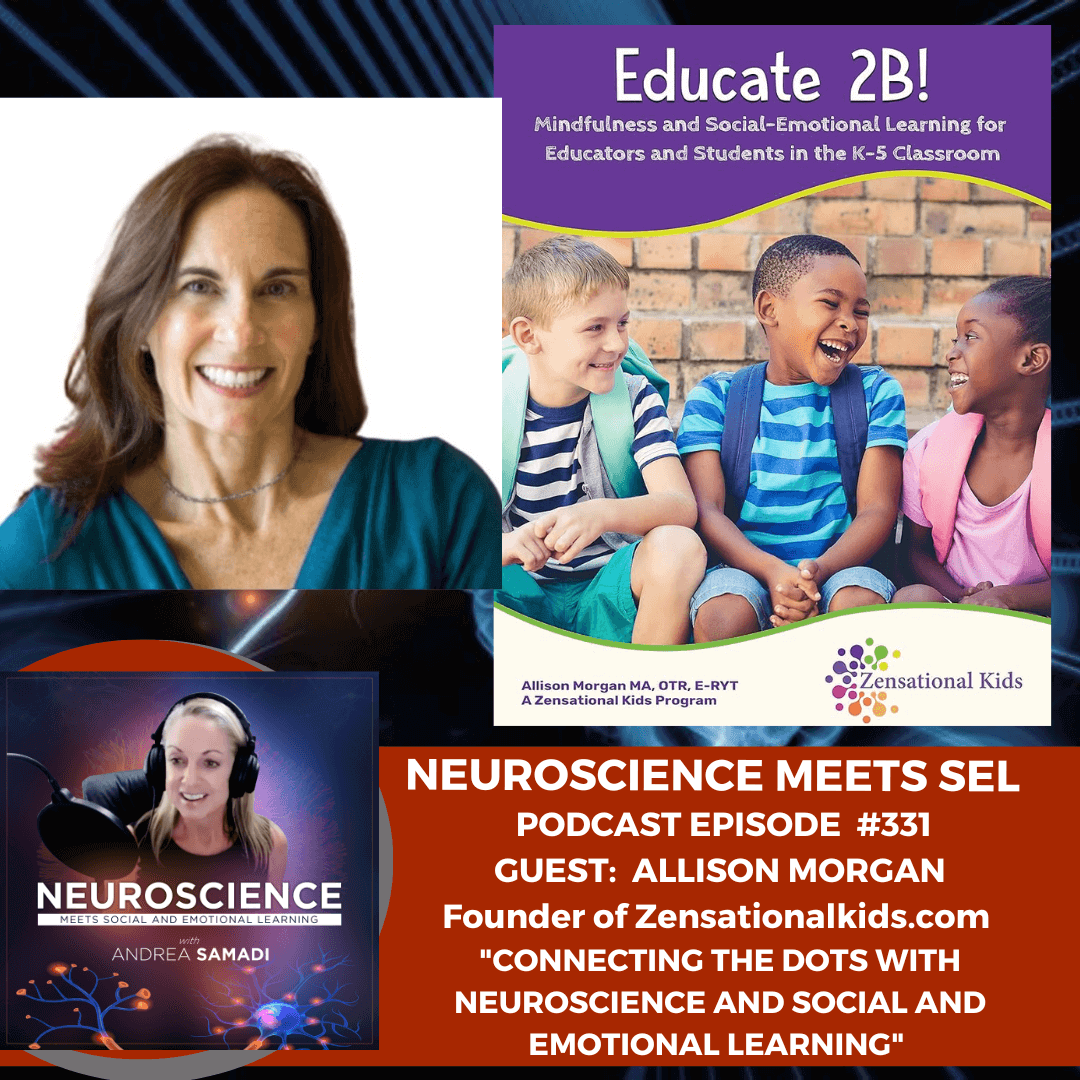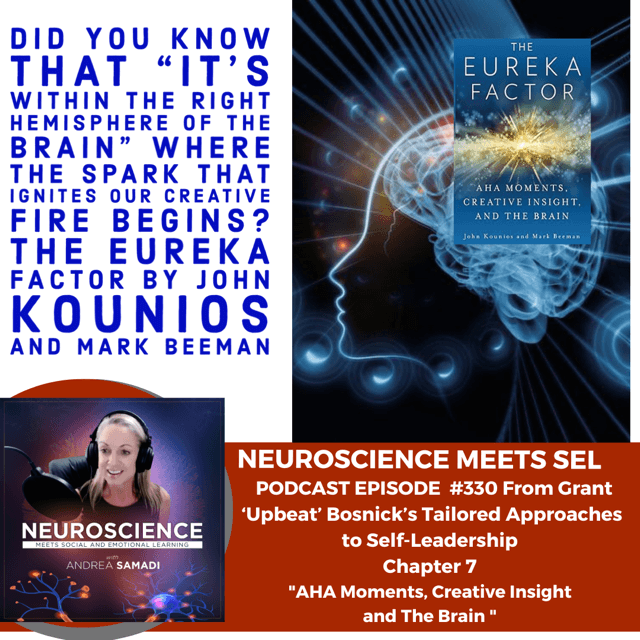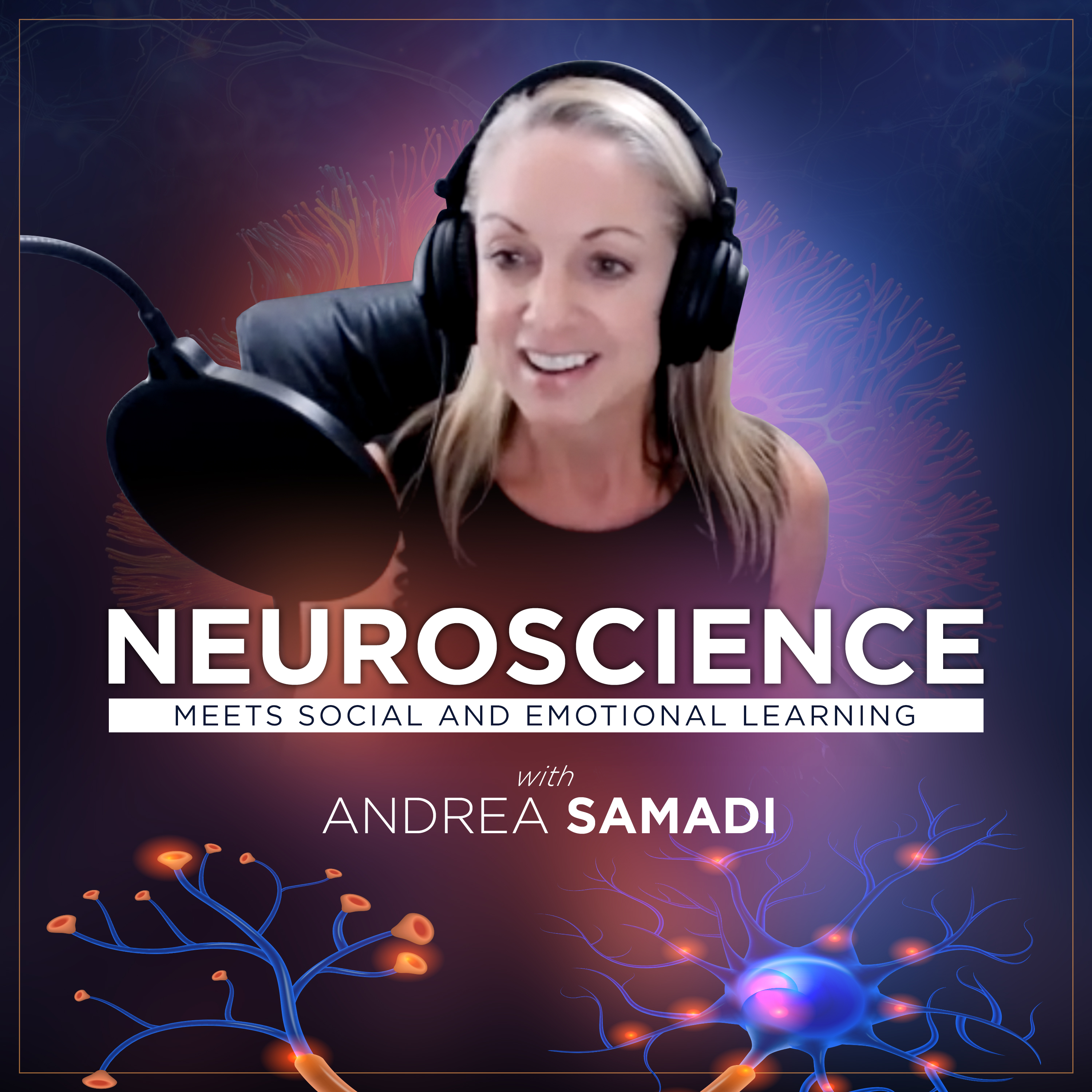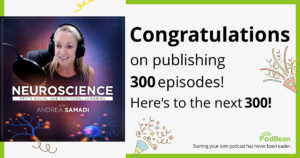Welcome back to the “Neuroscience Meets SEL Podcast” this is Andrea Samadi. Our goal with this podcast is to close the gap recent surveys show exists in our workforce where 58 percent of employers say college graduates aren’t adequately prepared for today’s workforce, and those employers noted a particular gap in social and emotional skills. Research shows that social-emotional skills like social awareness, self-regulation, and growth mindset are crucial to college and career readiness. The outcomes of developing these intelligences are vast as they impact our performance, leadership, personal excellence, time management, and decision-making.
We’ve chosen six social and emotional learning competencies to dive deep into and tie in how an understanding of our brain can facilitate these strategies. With each competency, we’ll investigate the best practices that you can use to develop and improve your own SEL/Emotional Intelligence and well-being practice, before extending these strategies to your districts, schools, classrooms, workplaces and communities. We want the ideas you take away with you to be actionable whether you are an educator working in a school, an employee or manager in a corporation, or someone just looking to take their skills to the next level. Be sure to look for the resources in the show notes section if you would like to dive deeper into this topic.
Our next competency is self-regulation.What is Self-Regulation and Why is it So Important?
Self-regulation is “the ability to manage your emotions and behavior in accordance with the demands of the situation. It includes being able to resist highly emotional reactions to upsetting stimuli, to calm yourself down when you get upset, adjust to a change in expectations and (the ability) to handle frustration”[i] In other words, it’s the ability to bounce back after a setback or disappointment, and the ability to stay in congruence with your inner value system.
The ability to control one’s behavior, emotions, and thoughts is an integral skill to be taught to young children as well, so they can form and maintain healthy relationships and connections later in life.[ii] As an adult, self-regulation is important in day to day life as we must learn how to handle and bounce back from life’s challenges and disappointments in our personal and professional lives. This skill is crucial to develop as we all know that life is full of ups and downs and we must be able to navigate through challenging situations before we can reach any level of achievement and success. We all know people who seem to bounce back after adversity. It’s not by luck or chance, it’s because they have learned how to self-regulate and intentionally get themselves back on course. This is a learned skill and one that we must teach or model to our students/children for them to be able to master it as adults.
Scott Bezsylko, the executive director of the Winston Prep school explains that they approach self-regulation skills “in the same way (they) approach other skills, academic or social: (they) isolate that skill and provide practice. When you think of it as a skill to be taught — rather than, say, just bad behavior — it changes the tone and content of the feedback you give kids.” [iii] Just like we would create a drill for improving dribbling for a basketball player, or practicing vocabulary words for a spelling test, we can create practice for self-regulation.
Self-Regulation Tips for Children
The key to teaching these skills to children is to model them, coaching younger children, until they can produce the results on their own.[iv]
-
- MODEL SELF-TALK: This works well with younger students as they learn how to identify their emotions. Teachers can model self-regulation in class by naming the emotions they are experiencing since we learn by watching others. Help students to recognize the emotions they have (for example-today I am feeling frustrated because I am stuck on my math problem) and offer a strategy on how to deal with the problem, perhaps by taking some deep breaths when they feel frustrated and to keep working the problem.
-
- ENCOURAGE SELF-CONTROL: If you are a student and value academic achievement, you’ll have the ability to complete your homework and make sacrifices to study for upcoming tests, instead of watching Netflix or going out with your friends. Teachers can offer tips and strategies that they used personally in pursuit of their goals by offering the rewards they gained from giving up something they liked to do to make time for study. This will build trust with students as they share their own stories and experiences.UNCOVER THE MOTIVATION: When students understand the importance of what they are studying, how it applies to the real world, or their daily life, there will be motivated to achieve that end goal. They must figure out how to make connections with what they are learning to motivate themselves intrinsically, learning for the fun of it, and become lifelong learners. Encourage students to make a game out of their learning to increase motivation.
- How do they learn best? Is it by taking notes, perhaps drawing images next to their notes to help them to identify and remember what they are learning? Do they remember what they are learning if they read their notes out loud? What strategies did you use to study and learn? Have students share their ideas with each other in a classroom discussion as one person’s ideas can help or encourage another to try something new.REACHING THOSE AHA! MOMENTS: When students start learning something new, they will go through different stages on the way to metacognition, where they are aware of what they are learning. When students can learn to form habits around how they learn best, with time and practice, they will learn how to naturally break through where they may become stuck, to experience the Aha! Moments when they finally understand something that might have escaped them for so long. Students must find ways to relax their brain and body and it’s during those “resting states” that remarkable activity takes place, allowing the brain to creatively solve problems, and take the student to new heights of achievement. Dr. Sriny Pillay, assistant professor of psychiatry at Harvard’s Medical School, talks about the power of building “unfocused time into your day” so that you can make better decisions, and become more productive whether you are in the classroom, or boardroom. Dr. Pillay brings in the latest brain research to prove that our brains must have time to rest in order to be productive and that too much focus causes brain fatigue. If you have ever noticed that great ideas come to you sometimes while in the shower, it’s this principle at work. The unfocused brain takes us to new places, insights, and Aha Moments, where focus cannot.
Einstein discovered his theory of relativity in a daydream he had (while he let his mind wander) and he used logic to explain it.
Steve Jobs explained that “you can’t connect the dots looking forward; you can only connect them looking backwards. So you have to trust that the dots will somehow connect in your future.” [vii] These Aha Moments might not be apparent until you look back at them.
So how does self-regulation translate into the workplace? To reach these high levels of achievement in the workplace, there’s more involved than just using your self-control and your will power. The executive functions of your brain are involved, and we have mentioned in previous episodes that in order to self-regulate, our brain must work right. We must put brain health first by getting enough sleep, nutrition, supplements and exercise, and when our brain works right, we work right. We must have strategies to calm down our emotions first, since our executive functions won’t be working right while we are under stress. Whether that means taking some deep breaths or walking away to recalibrate.
Here are 3 Self-Regulation Tips for the Workplace
-
- EMBRACE THE DAILY GRIND: Remember that when you are working on something that’s important to you, the more time and effort you put in, focused on this goal, that things don’t get easier for you in this pursuit—they become more difficult. When you become better at what you are doing, gaining more competence, you will gain more success, but things won’t get easier for you—as we would imagine—they get harder as more challenges appear. When you are working, taking action, and doing something, problems and obstacles will show up. Those who are the most successful in their craft will understand and embrace that hardship with daily focus, and consistent practice to overcome the obstacles. With focus, persistence and daily practice, confidence will develop and will propel you forward.REMEMBER THAT WE HAVE A CHOICE: When difficult situations arise, we have three choices. We can approach (by asking questions), avoid, or attack.
-
- The best results obviously occur when we are able to respond to a situation (approaching it with understanding) rather than react (by avoidance or attack) by asking questions to uncover more and see if there might be something we are missing or some sort of miscommunication. We always have a choice on how we respond to situations. The research is clear that mindfulness and meditation can help increase the gap between a stimulus and our response to it, so those who have developed their own practice, will find making this choice to respond vs react, much easier.
-
- LEARN TO “SWITCH” IT OFF: Once you are clear on the situation, if your feathers were ruffled and you didn’t like something that occurred, you must have a strategy in place to switch off the emotions that you feel so that you don’t react. An effective strategy used in cognitive behavioral therapy
- is to say the word “SWITCH” in your head as you focus on switching the negative emotion that you feel to something more positive. We all have automatic negative thoughts that come into our head at times, but we must have a strategy to stop them from ruminating or continuing in a loop, since we know that switching off these negative thoughts is an important step towards self-regulation and moving us towards our goals. I’ve always used the strategy of saying “STOP” when this happens and changing the thought pattern in my head to something more productive.
Outcomes and Results
Self-regulation develops, grows and improves from birth through young adulthood and beyond.[xi] As parents, and teachers working with our students in the classroom, modeling these strategies will be crucial for our students to begin to implement and grasp them. As students move from high school and into the workplace, developing a mindfulness and meditation strategy early on can only further strengthen this skill so that we can provide our best selves in our community, families or workplaces.
Thank you for staying to the end of this episode. Stay tuned for more interviews this week with students who have been applying these principles for the past five years and are returning to share the results they have created in their lives. Next week we will cover the Mindset competency, and move into the Cognitive Track, where we will dive deep into our brain and how are results (personally and professionally) are all controlled by this powerful organ.
RESOURCES:
30 Games and Activities for Self-Regulation https://theinspiredtreehouse.com/self-regulation/
Strong Self-Regulation Skills: Why They are Fundamental by Committee for Children YouTube Published August 1, 2016 https://www.youtube.com/watch?v=m4UGDaCgo_s&feature=youtu.be
Emotional Self-Regulation Techniques for Teaching https://www.crisisprevention.com/Blog/October-2016/emotional-self-regulation
Using Your Brain to Get You to Where You Want to Go: Guide for High School Students https://schoolsocialwork.net/wp-content/uploads/2013/07/Brain_Drivers_Education-Operators_Guide.pdf (Massachusetts General Hospital, 2010) This document is available under a royalty-free license at www.schoolpsychiatry.org
Bradley University: How to Teach Clients Self-Regulation Skills https://onlinedegrees.bradley.edu/blog/how-to-teach-clients-self-regulation-skills/
Curriculum for Teaching Emotional Self-Regulation by Scott Carchedi July 24, 2014 https://schoolsocialwork.net/curriculum-for-teaching-emotional-self-regulation/
Middle and High School Self-Regulation Lessons https://apps.esc1.net/ProfessionalDevelopment/uploads/WKDocs/71257/Self-Regulation%20Lessons.pdf
REFERENCES:
[i] How Can We Help Our Kids with Self-Regulation https://childmind.org/article/can-help-kids-self-regulation/amp/
[ii] How to Practice Self-Regulation https://www.verywellmind.com/how-you-can-practice-self-regulation-4163536
[iii] How Can We Help Our Kids with Self-Regulation https://childmind.org/article/can-help-kids-self-regulation/amp/
[iv] How Can We Help Our Kids with Self-Regulation https://childmind.org/article/can-help-kids-self-regulation/amp/
[v] Edutopia article “Teaching Self-Regulation by Modeling” (January, 2019) https://www.edutopia.org/video/teaching-self-regulation-modeling
[vi] Motivation and Self-Regulated Learning https://education.stateuniversity.com/pages/2249/Motivation-SELF-REGULATED-LEARNING.html
[vii] Steve Jobs Stanford University Commencement Speech https://news.stanford.edu/2005/06/14/jobs-061505/
[viii] How to Practice Self-Regulation https://www.verywellmind.com/how-you-can-practice-self-regulation-4163536
[ix] Mindfulness, Meditation and Executive Control https://academic.oup.com/scan/article/8/1/85/1694475
[x] What is Cognitive Behavioral Therapy with Therapist Kati Morton YouTube uploaded Sept. 23, 2013 https://www.youtube.com/watch?v=g7B3n9jobus
[xi] Seven Key Principles of Self-Regulation https://www.acf.hhs.gov/sites/default/files/opre/srts_7_principles_brief_revised_2_15_2017_b508.pdf
Podcast: Play in new window | Download
Subscribe: Apple Podcasts | RSS
